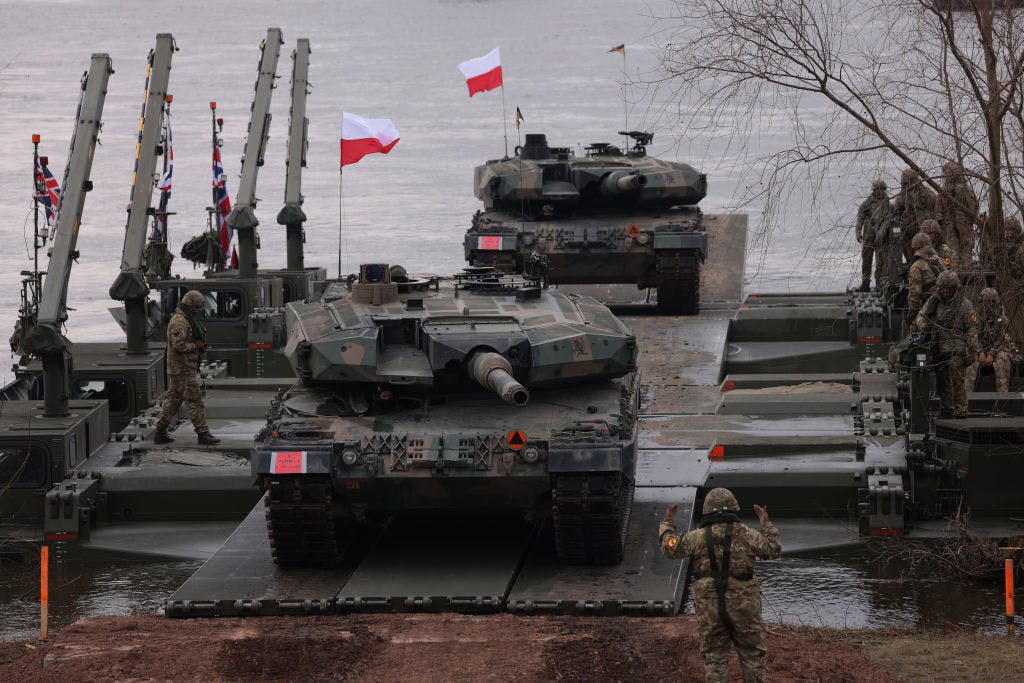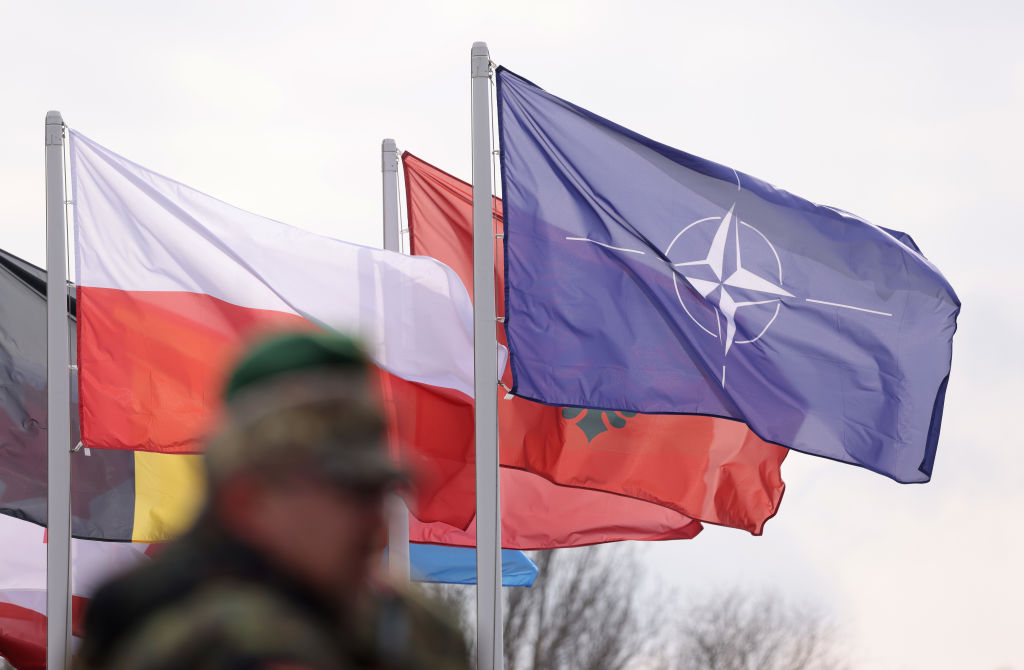A New Iron Curtain Is Emerging Along a North-South Line in an Eastern Europe Fearful of Moscow’s Aggression
Putin says he invaded Ukraine to push back NATO. Instead, his invasion is sparking his nearest western neighbors to ramp up their defenses.

Romania is building NATO’s largest military base in Europe. Poland is negotiating to host American nuclear weapons. Finland, long known for “Finlandization,” or studied neutrality, is now in NATO and calls itself “a front-line state.”
Vladimir Putin says he invaded Ukraine to push back NATO. Instead, Russia’s nearest western neighbors are closing ranks as a new Iron Curtain takes shape along a north-south front against Russian expansionism. The neighbors wonder: Could we be next?
Starting from the south, Bulgaria last month shipped to Ukraine 100 Soviet-era BTR-20 armored personnel carriers and armored scout cars. Long seen as Russia’s closest “Slavic Brother,” Bulgaria’s capital has a monument to Tsar Alexander II, the Russian leader who freed Orthodox Christian Bulgaria from Turkish rule.
Modern Russia’s bombing of Mariupol and destruction of historic Bulgarian communities in Ukraine, though, soured Bulgarians on their “older brother.”
Further up the Black Sea coast, Romania broke ground this spring on a 10-square mile expansion to Mihail Kogălniceanu International Airport, Romania’s closest air base to Russia-controlled Crimea.

Destined to host F-16 and F-35 warplanes, the new base will include two new airstrips, as well as housing, schools and a hospital for 10,000 NATO soldiers and their families. The $2.5 billion project is designed to be a Ramstein Air Base for eastern Europe.
“An American city will appear in Constanta County,” warns a Russian news site, Reporter. Facing Crimea 250 miles across the Black Sea, Constanta is Romania’s biggest sea port. Before the war closed the Black Sea to outside navies, Constanta was a regular port of call for American Navy ships.
The base project is being fast tracked by Romania’s president, Klaus Iohannis. In March, he announced his candidacy for NATO secretary general. Facing tough competition from the outgoing Dutch prime minister, Mark Rutte, Mr. Iohannis burnished his NATO credentials last month by announcing that 50 Ukrainian pilots will undergo F-16 training at Fetești Air Base, NATO’s European F-16 Training Center.
To keep the war on the far side of the Danube River, Romania has refrained from loud protests over the five Russian kamikaze drones that have fallen on Romanian territory since the 2022 invasion. After four decades under Communist rule, Romanians are acutely aware of deeply ingrained Russian imperial attitudes.
On March 15, the former Russian president, Dmitry Medvedev, alluded to the Romani, or gypsy, influence on Romania’s national culture, posting on social media site VK: “Romanians, as you know, are not a nation, but a way of life.”
Mr. Medvedev, currently deputy chairman of Russia’s Security Council, was objecting to a European Parliament resolution urging Moscow to return 91 tons of Romanian gold it has held since World War I. Calling the resolution “impudence,” Mr. Medvedev said Moscow keeps the gold to punish Romanians for “bad behavior.”
Moving up Russia’s border, some Poles think about Russia and start thinking about going nuclear. Two weeks ago. Poland’s president, Andrzej Duda, met in America, separately, with President Biden and President Trump. Later, he told Polish newspaper Fakt: “If our allies decide to deploy nuclear arms on our territory as part of nuclear sharing, to reinforce NATO’s eastern flank, we are ready.”
Five NATO nations “host” American tactical nuclear weapons on their territories: Belgium, Germany, Italy, the Netherlands and Turkey. Control remains in American hands, but forward deployment is seen as a deterrent to Russia. In Belarus, a Russian satellite nation to the east of Poland, President Alexander Lukashenko said Thursday that “dozens” of Russian tactical nuclear weapons now are stored there.
President Gitanas Nausėd of Lithuania, a Baltic nation bordering on Poland and Belarus, supports Mr. Duda’s move to store American nuclear weapons. The Kremlin’s reaction is icy.
“Polish authorities have made no secret of their ambitions in terms of how to ‘cuddle up to’ the U.S. nuclear weapons deployed in Europe, they have been talking about this for a long time,” a Russian foreign ministry spokesman, Maria Zakharova, told reporters last week.
“The impression is that Warsaw is maniacally seeking to attract even more attention from military planners in the Russian General Staff,” she added, predicting that any storage site would immediately become a target for Russian missiles.
With some Poles saying that their president’s nuclear invitation was not thought through, Mr. Duda meets today with his political rival, Prime Minister Donald Tusk, to work out a joint policy. Both men are in agreement that the Russian threat is real. They believe that it probably would not come from Kaliningrad, Russia’s exclave bordering Poland, but through Ukraine.
“We have a choice: Either we have a defeated Russian army outside the borders of Ukraine or a victorious Russian army on the border with Poland,” Poland’s foreign minister, Radek Sikorski, told German newspaper Bild in an interview published Sunday.
Saying he “wouldn’t be surprised at all” if Russia attacks, he added: “Russia has attacked Poland many times in the 500 years of our history. But in this scenario, Russia will lose, because we, the West, are far more powerful than Russia.”
Determined to build NATO’s largest army in Europe, Poland is on track to spend 4 percent of its gross domestic product on defense — double the NATO goal of 2 percent. In addition to large arms purchases from America, Poland is buying more than 1,000 tanks, self-propelled howitzers, multiple rocket launchers and fighter jets from South Korea. In February, NATO and Ukraine agreed to create a joint training center at a Polish city, Bydgoszcz, midway between Warsaw and the Baltic.
Further up the Baltic, the admission to the North Atlantic Treaty of Finland and then Sweden over the last year turned the Baltic Sea into a North Atlantic Treaty Organization sea. While the Baltics host this spring the largest NATO exercise since the Cold War, the biggest turnaround is Finland.
Finland’s entry to NATO turned a thinly monitored 832-mile land border into a tense, closely surveilled front line. First, Russia encouraged 1,000 economic migrants without visas for Europe to swarm across the border.
After Finland closed all land crossings with Russia, the Kremlin responded by recreating two Soviet-era military districts facing Finland and by stationing nuclear capable Iskander missiles in Karelia, a border area with historic ties to Finland.
“If this comes true, it won’t change anything,” Finland’s former director of military intelligence, Harri Ohra-aho, writes on X. “Operationally it seems absurd to bring missile systems with such a long range closer to our border. They make easy targets for us.” Finland is bulking up with traditional defenses: American rocket systems, F-35 jet fighters, and Israeli anti-tank and air-defense systems.
Russia, though, seems to be taking a non-confrontational, hybrid approach. GPS jamming this spring caused two Finnair flights to divert to alternate cities and forced the company to suspend all service to Estonia’s second largest city, Tartu, until a non-GPS navigational system is installed. Then, too, there is the mystery about an undersea communications cable that was cut last year between Estonia and Finland.
The Kremlin calls it paranoia. “The idea that we will attack some other country — Poland, the Baltic States, and the Czechs are also being scared — is complete nonsense. It’s just drivel, ” Mr. Putin said in late March. In the next breath, though, he warned that any NATO air base hosting Ukraine’s new F-16 fighter jets will be a “legitimate target” for his forces.

